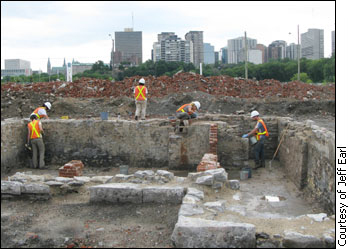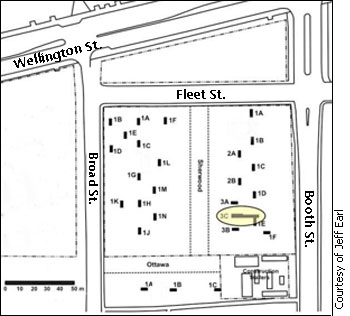Jean is a young French Catholic boy growing up on LeBreton
Flats. His parents work in the mills at Chaudière Falls.
Every morning he puts on his shoes, they are made of leather
and held together with small copper nails. They were made
by a nearby shoemaker, and last year he wore holes in a pair
that now sit in the trash heap behind his house.
After breakfast,
he and his little sister Marie walk down to the one room
schoolhouse, Ste-Famille French Separate School on Sherwood
Street, for their lessons. Marie clutches her doll tight,
its porcelain face peering up at Jean from the crook of her
little arm.
| 'The history books
we have don't really tell us a lot about the lives of
the working class people. ' |
At lunch time they go outside for a game of marbles, where the boys compete with
their clay marbles to try and win Jean's special glass marble. One of the boys
shows off his new lead toy pistol and the rest of the boys watch with quiet admiration.
After a long day of lessons, Jean and Marie go home in the afternoon and have
oysters from the Ottawa River for dinner.
These are just some of the small details that paint a picture of life on LeBreton
Flats, provided by the artifacts and discoveries of the ongoing archaeological
excavations of the area.
"The history books we have don't really tell us a lot about the lives of
the working class people," says Jeff Earl, the lead archaeologist of on
the excavation of Ste-Famille. "It's just been a great
way to discover a little bit about them."
Since 2000, the National Capital Commission has contracted out salvage excavations
of several sites on the LeBreton Flats in order to begin housing developments
and the construction of the War Museum in the area.
 |
| The post-1900 foundation of Ste-Famille
Separate School was built on top of the remains of the
original. |
Salvage archaeology is done in order to find and record archaeological evidence
before putting up new buildings.
The NCC purchased the land in the 1960s and everything standing was demolished.
But the school house was destroyed before that by a devastating fire that swept
through the area in 1900. A new school was rebuilt on top of the old foundation.
Archaeologists found both foundations in their excavation last summer.
You can see the evidence of the fire in the stratigraphy, Earl says, which means
the layers of the past are marked in the soil by lines of different coloured
rock and sediment. The layer from 1900 is thick black ash.
"Because of the great fire that swept through in 1900, we've been able to
find that fire layer in lots of parts of the Flats," says Earl. "If
you can identify that layer you know that all of the layers
below it pre-date 1900 and all of the layers on top of it
were post-1900."
The archaeologists can use this as a marker for dating all of their finds.
Earl and his company, Past Recovery, finished excavating the grounds last season
around the Ste-Famille school, which dates back to 1880 and a train station from
1870. From 1860 to 1880, there were two houses and outbuildings where the schoolyard
would later be. They were demolished when they put up the school in 1880, but
evidence of them still remains.
 |
| The school was located on Sherwood
Street, which was between Broad
and Booth Streets south of Wellington. |
"Since there was no later 20th Century construction in the schoolyard itself," says
Earl, "It preserved any remains from those houses. That
we found really interesting because there was such a short
20 year period, so we got a really good snapshot of the lives
of those inhabitants."
The personal items are of most interest to Earl. In one case, a unique shoe.
"Usually in the bottom of the sole there's rows of nails all around the
exterior and the heels sort of holding them together. But this one also had a
pattern of a heart in small nails on the inside," says
Earl.
The artifacts will be processed and catalogued by the archaeological team. They
are property of the NCC who are curating them for now. The excavation of the
school and the train station were the last major excavations of LeBreton Flats.
Front page courtesy of Jeff Earl
|

